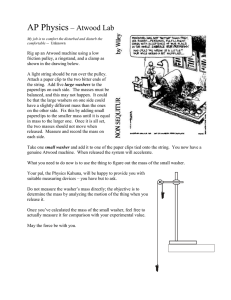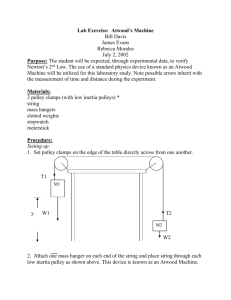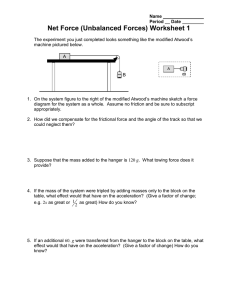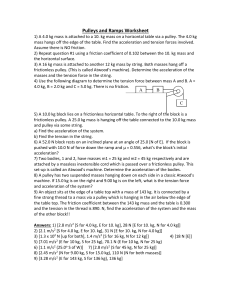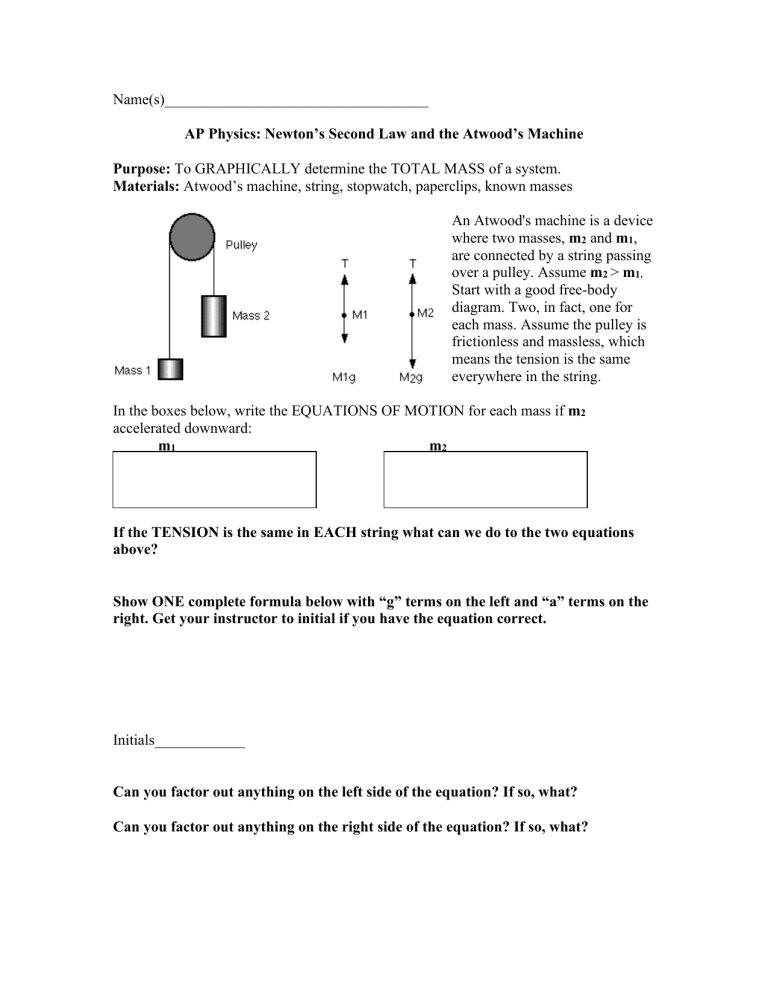
Name(s)___________________________________ AP Physics: Newton’s Second Law and the Atwood’s Machine Purpose: To GRAPHICALLY determine the TOTAL MASS of a system. Materials: Atwood’s machine, string, stopwatch, paperclips, known masses An Atwood's machine is a device where two masses, m2 and m1, are connected by a string passing over a pulley. Assume m2 > m1. Start with a good free-body diagram. Two, in fact, one for each mass. Assume the pulley is frictionless and massless, which means the tension is the same everywhere in the string. In the boxes below, write the EQUATIONS OF MOTION for each mass if m2 accelerated downward: m1 m2 If the TENSION is the same in EACH string what can we do to the two equations above? Show ONE complete formula below with “g” terms on the left and “a” terms on the right. Get your instructor to initial if you have the equation correct. Initials____________ Can you factor out anything on the left side of the equation? If so, what? Can you factor out anything on the right side of the equation? If so, what? Factor out the terms mentioned above and show the equation below. Now show your equation using the following model: In other words, your equation should look similar to what is shown. X(Y-Z) = (A+B)C We are now going to use this model and compare it to another MODEL you are already familiar with: Place your equation in the last set of boxes. X(Y-Z)= (A+B) C y= m x+ b N/A Let’s see if we can identify the important factors for our graph The Rise = The Run = The Slope = Procedure: 1) Set up the Atwood’s Machine as shown in the diagram. You will need to obtain the pulley from F/M kit and remove it from the clamp. Screw the pulley to a support rod that goes through a small mounting hole on the smart gate. 2) Place a large mass on BOTH ends of the machine. Make sure the masses are equal. Obtain 2 large paper clips. These will be attached to the TOP of each mass and act like a hook. 3) Acquire 10 small metal washers. MEASURE and RECORD the TOTAL MASS of the system. The washers will represent the masses being transferred between sides. Start with 6 on one side and 4 on the other. 4) Measure and record the MASS DIFFERENCE between the TWO sides. 5) Hold the larger mass at the top of the Atwood’s Machine. 6) Pair the smart gate with SparkVue. 7) The SMART GATE has many different settings to choose from. We want a SMART GATE with PULLEY. It will ask you about the spoke width. The default is 0.015 m. Keep this value. 8) Choose GRAPH only for the template. Click start on SparkVue. 9) Release the mass. 10) The acceleration should be constant. Use the STATISTICS button and choose MEAN to obtain the acceleration. Record this value. 11) Repeat TWO extra times to get an average acceleration. 12) Repeat the ENTIRE experiment again with paper clip differences of 7/3, 8/2, 9/1, 10/0 Data Table Total Mass of the System = ______________________ Paper Clip Combo 6/4 Mass Difference Acceleration (m/s/s_ A1 A2 A3 A2 A3 A2 A3 A2 A3 A2 A3 AVG 7/3 A1 AVG 8/2 A1 AVG 9/1 A1 AVG 10/0 A1 AVG Fill in the following table Paper Clip Combo “g” times Mass Difference Acceleration 6/4 7/3 8/2 9/1 10/0 Make the appropriate graph mentioned earlier in the pre-lab and find the SLOPE. The SLOPE will equal the TOTAL MASS of the system. Snip your graph below. SLOPE __________________ Using the ACTUAL value for the total mass (Paper Clips+Washers + hanging masses) as measured from the balance, calculate a % error. 𝐴𝑐𝑡𝑢𝑎𝑙 − 𝐸𝑥𝑝𝑒𝑟𝑖𝑚𝑒𝑛𝑡𝑎𝑙 % 𝑒𝑟𝑟𝑜𝑟 = | | 𝑥100 𝐴𝑐𝑡𝑢𝑎𝑙

